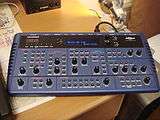Novation Supernova
| SuperNova | |
|---|---|
|
Novation SuperNova II (rear) | |
| Manufacturer | Novation |
| Dates | 1998 - 2000 |
| Technical specifications | |
| Polyphony | 20 voices (expandable to 32) |
| Timbrality | 8 |
| Oscillator | 3 oscillators per voice, (saw, variable width square) |
| LFO | 2 saw, square, tri, sample/hold |
| Synthesis type | Virtual analog Subtractive |
| Filter | 1 resonant 12/18/24 db low/high/bandpass |
| Attenuator | 1 ADSR |
| Aftertouch expression | n/a |
| Velocity expression | n/a |
| Storage memory | 512 (expandable to 1,024) patches; 256 performances |
| Effects | Distortion, reverb, chorus, flange, phaser, delay, pan, tremolo, 2-band EQ, comb filtering |
| Input/output | |
| Keyboard | {{{keyboard}}} |
| External control | MIDI |
The Novation SuperNova, released in 1998, was a 3U rack-mounted virtual analogue polyphonic synthesizer with 16+ note polyphony and multitimbral operation, made by the British company Novation. One important feature being the provision of multiple effects units which could be assigned to each timbre, allowing a much richer sound than had generally been possible with a multitimbral synthesizer. The SuperNova and its successor, the SuperNova II, have been used by a wide range of artists including Orbital, ATB, The Faint, Sin, Jean Michel Jarre and A Guy Called Gerald.[5]
Overview
The Novation SuperNova was first produced in 1998 in the midst of a highly competitive virtual analogue synthesizer market to compete with the Roland JP-8000, the Clavia Nord Lead, the Korg Prophecy, the Yamaha AN1x, and the Access Virus, among others. It offers many of the same features as its competitors, such as accurate digital imitations of analogue subtractive synthesizer architecture and a resonant (self-oscillating) filter, as well as having the MIDI functionality of a modern synth.
Some key differences however are: it featured no triangle or sine wave (simpler waves such as these had to be arrived at using a unique hardness attenuator by softening either the saw or square), its polyphony and multitimbrality were superior to its competitors, and it had an extremely powerful effects engine that could provide 7 simultaneous effects with no loss of polyphony. At the time, the SuperNova's effects engine greatly surpassed all other synths and was considered a key element in the instrument's sound.
The SuperNova II (2000) was available in 24, 36 and 48-voice models with additional 12 or 24-voice expansion boards. Available again in a 3U rack-mount format, the SuperNova II was also available in a 61-note performance keyboard version with velocity and aftertouch, enabling sound tweaking during live performance. FM synthesis capability was included along with ring modulation, dual analogue inputs and a 42-band vocoder. An 8-part arpeggiator was also on-board and in its full version the product offered 8-part multitimbrality and 48-voice polyphony, with 57 and 2304 oscillators running simultaneously.
The Supernova II was discontinued in 2001.

The Novation Nova was also available as a cut down desktop synth and the Nova II pro keyboard.